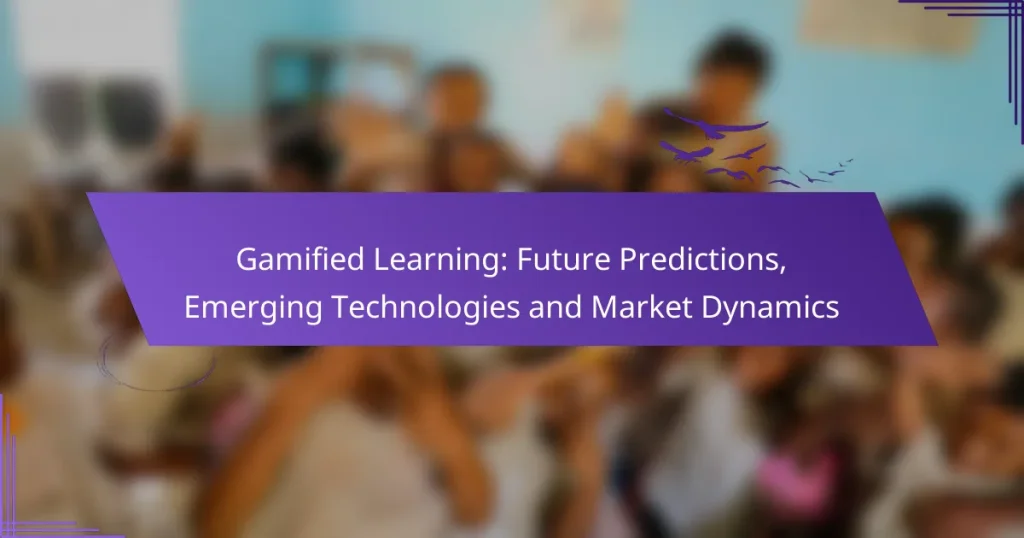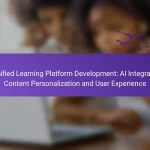Gamified learning is revolutionizing online education by incorporating game-like elements that boost student engagement and motivation. With the integration of emerging technologies such as artificial intelligence and virtual reality, this approach personalizes educational experiences and enhances interactivity. As demand for engaging learning solutions grows, the market is evolving to deliver more accessible and rewarding educational content.

How is gamified learning transforming online courses in the US?
Gamified learning is significantly changing online courses in the US by integrating game-like elements that enhance student engagement and motivation. This approach not only makes learning more enjoyable but also helps students achieve better outcomes through interactive and rewarding experiences.
Increased engagement through interactive elements
Interactive elements such as quizzes, challenges, and leaderboards are crucial in gamified learning. These features encourage active participation, making students more likely to complete courses and retain information. For instance, incorporating a point system can motivate learners to engage more deeply with the material.
Additionally, using multimedia content like videos and simulations can further enhance engagement. By providing varied formats, students can choose how they interact with the content, catering to different learning styles and preferences.
Enhanced retention via game mechanics
Game mechanics such as rewards, levels, and achievements can significantly boost information retention. When learners earn badges or unlock new levels, they are more likely to remember the material associated with those accomplishments. This method taps into the psychological principles of motivation and achievement.
To maximize retention, course designers should align game mechanics with learning objectives. For example, a course could offer rewards for completing modules, reinforcing the importance of each section while keeping the learning experience enjoyable.
Real-time feedback and progress tracking
Real-time feedback is a key advantage of gamified learning, allowing students to understand their performance instantly. Immediate responses to quizzes or interactive tasks help learners identify areas for improvement, fostering a growth mindset. This timely feedback can be more effective than traditional assessments that provide results only after a delay.
Progress tracking features, such as dashboards that display achievements and milestones, can also motivate learners. By visualizing their journey, students can set personal goals and stay committed to their learning path, enhancing overall course completion rates.
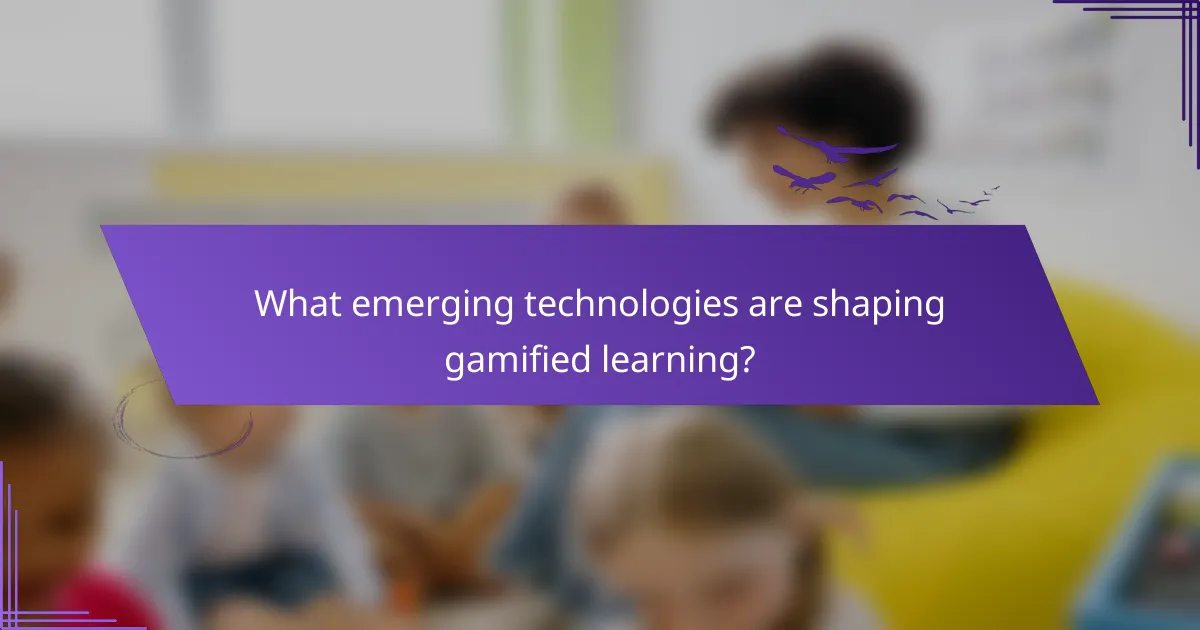
What emerging technologies are shaping gamified learning?
Emerging technologies are significantly transforming gamified learning by enhancing engagement and personalizing educational experiences. Key innovations such as artificial intelligence, virtual reality, and blockchain are driving these changes, making learning more interactive and rewarding.
Artificial intelligence for personalized experiences
Artificial intelligence (AI) tailors learning experiences to individual needs by analyzing user data and adapting content accordingly. This personalization can improve engagement and retention, as learners receive challenges suited to their skill levels and preferences.
For example, AI-driven platforms can assess a learner’s progress and adjust the difficulty of tasks in real-time, ensuring that users remain challenged but not overwhelmed. This adaptive approach can lead to more effective learning outcomes.
Virtual reality for immersive learning
Virtual reality (VR) creates immersive environments that enhance the learning experience by allowing users to engage with content in a three-dimensional space. This technology can simulate real-world scenarios, making complex subjects easier to understand and more relatable.
For instance, VR can be used in medical training to allow students to practice procedures in a safe, controlled environment. This hands-on experience can significantly improve skill acquisition and confidence before entering real-life situations.
Blockchain for credentialing and rewards
Blockchain technology offers secure and transparent methods for credentialing and rewarding learners. By utilizing decentralized ledgers, educational achievements can be verified without the need for intermediaries, ensuring authenticity and reducing fraud.
Additionally, blockchain can facilitate reward systems where learners earn tokens or credits for completing tasks. These rewards can be used for future learning opportunities or even exchanged for tangible benefits, encouraging continued engagement in gamified learning environments.

What are the market dynamics driving gamified learning?
The market dynamics driving gamified learning include the increasing demand for engaging educational experiences, advancements in technology, and a shift towards remote learning solutions. These factors are reshaping how educational content is delivered, making it more interactive and accessible.
Growing demand for remote learning solutions
The rise of remote learning has significantly boosted the demand for gamified learning solutions. As educational institutions and businesses seek to engage learners from various locations, gamification offers a way to enhance motivation and retention through interactive elements.
For instance, platforms that incorporate game mechanics, such as points, badges, and leaderboards, can foster a sense of competition and community among remote learners. This trend is particularly relevant in regions with limited access to traditional educational resources.
Investment trends in educational technology
Investment in educational technology, particularly in gamified learning platforms, has seen substantial growth. Venture capitalists and educational institutions are increasingly funding startups that focus on innovative learning solutions that integrate gamification.
Investors are drawn to the potential for high returns as gamified learning becomes a staple in both K-12 and higher education. This trend is expected to continue, with funding often directed towards platforms that demonstrate measurable improvements in learner engagement and outcomes.
Competitive landscape of gamified platforms
The competitive landscape for gamified learning platforms is rapidly evolving, with numerous players entering the market. Established educational technology companies are expanding their offerings to include gamified elements, while new startups are emerging with fresh ideas and approaches.
To stand out, platforms must focus on user experience, content quality, and the effectiveness of their gamification strategies. Features such as personalized learning paths and adaptive challenges can provide a competitive edge in attracting and retaining users.
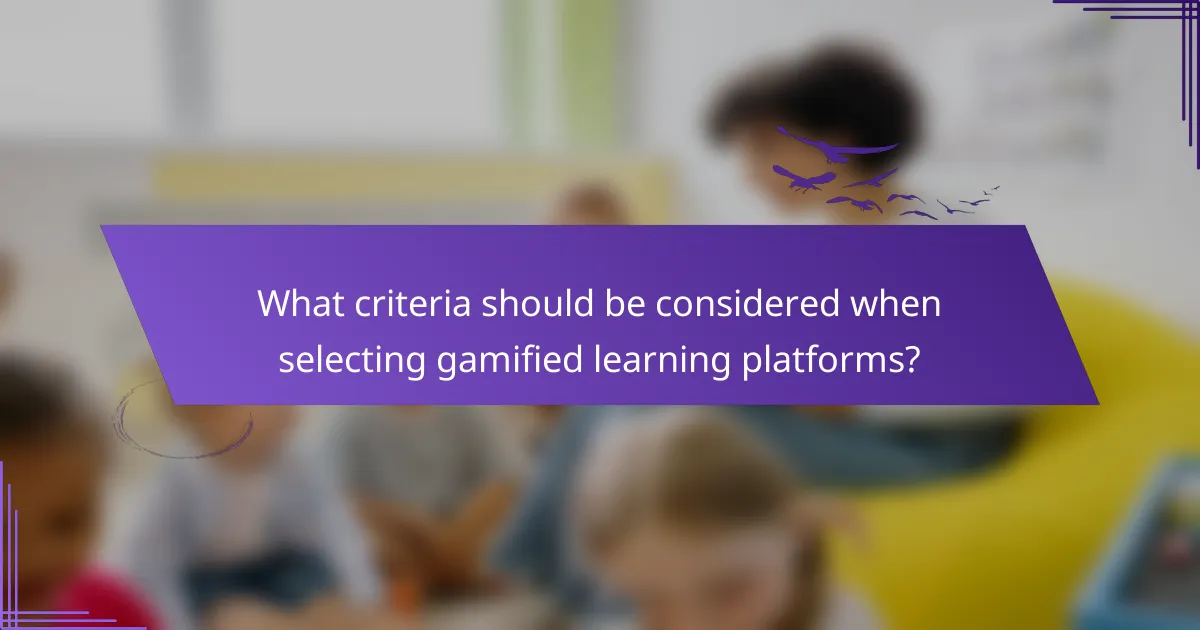
What criteria should be considered when selecting gamified learning platforms?
When selecting gamified learning platforms, consider user engagement, content quality, and integration capabilities. These criteria ensure that the platform not only captivates learners but also aligns with existing educational frameworks and technologies.
User experience and interface design
User experience (UX) and interface design are crucial for gamified learning platforms. A well-designed interface should be intuitive, allowing users to navigate easily without confusion. Look for platforms that prioritize engaging visuals and interactive elements, as these can significantly enhance motivation and retention.
Consider the age group and learning preferences of your audience. For younger learners, colorful graphics and playful animations may be effective, while adult learners might prefer a more streamlined and professional design. Always test the platform with actual users to gather feedback on usability.
Integration with existing learning management systems
Integration with existing learning management systems (LMS) is essential for seamless implementation. A gamified platform should easily connect with your current LMS to ensure that tracking progress and managing content is straightforward. Check for compatibility with popular LMS like Moodle, Canvas, or Blackboard.
Evaluate the technical requirements for integration, including APIs and data transfer protocols. Platforms that offer single sign-on (SSO) capabilities can simplify user access and enhance the overall experience. Avoid platforms that require extensive customization, as this can lead to increased costs and implementation time.
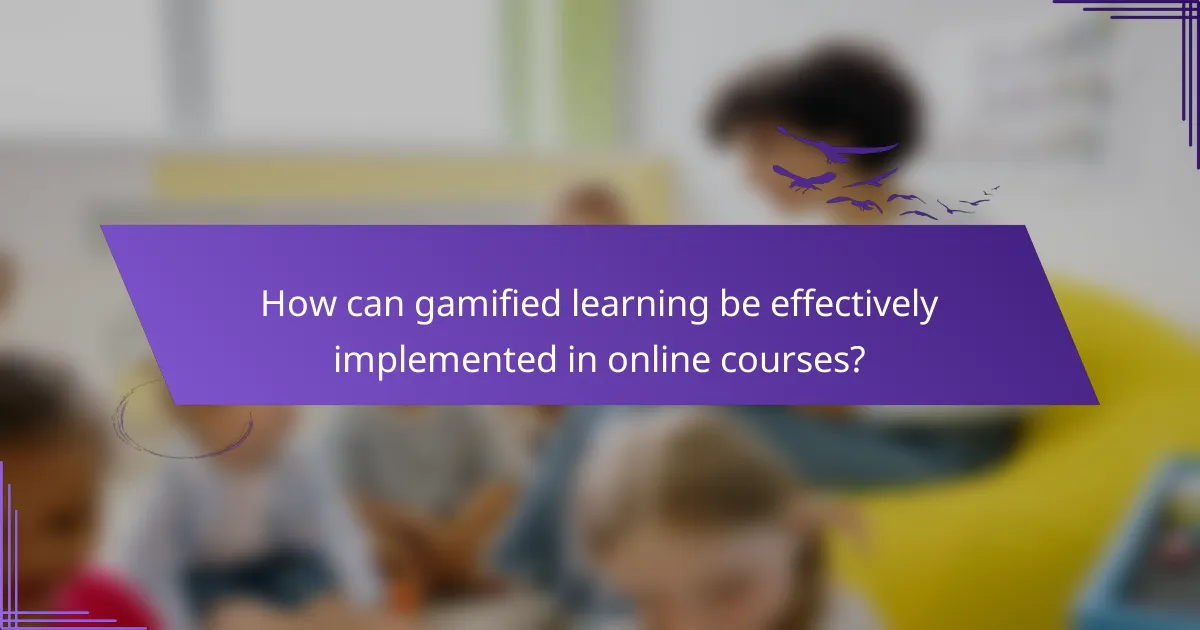
How can gamified learning be effectively implemented in online courses?
Effective implementation of gamified learning in online courses involves integrating engaging game elements that motivate learners while aligning with educational goals. By focusing on clear objectives, diverse game mechanics, and continuous assessment, educators can enhance the learning experience and improve outcomes.
Define clear learning objectives
Establishing clear learning objectives is crucial for successful gamified learning. These objectives should be specific, measurable, achievable, relevant, and time-bound (SMART) to guide both the design of the course and the learners’ progress.
For instance, instead of a vague goal like “understand math concepts,” a clear objective could be “solve algebraic equations with 80% accuracy by the end of the course.” This clarity helps learners know what to focus on and allows for better tracking of their progress.
Incorporate diverse game mechanics
Diverse game mechanics can significantly enhance engagement in online courses. Incorporating elements like points, badges, leaderboards, and challenges can motivate learners to participate actively and strive for mastery.
For example, a course could reward students with points for completing quizzes or participating in discussions, while badges could signify achievements like mastering a topic. This variety keeps the learning experience dynamic and encourages healthy competition among peers.
Measure learner outcomes and adapt strategies
Measuring learner outcomes is essential to evaluate the effectiveness of gamified learning. Regular assessments, feedback loops, and analytics can provide insights into how well students are achieving the defined objectives.
Based on these measurements, educators should be prepared to adapt their strategies. If a significant number of learners struggle with a specific game element or topic, it may be necessary to modify the approach, such as providing additional resources or altering the game mechanics to better suit the learners’ needs.
